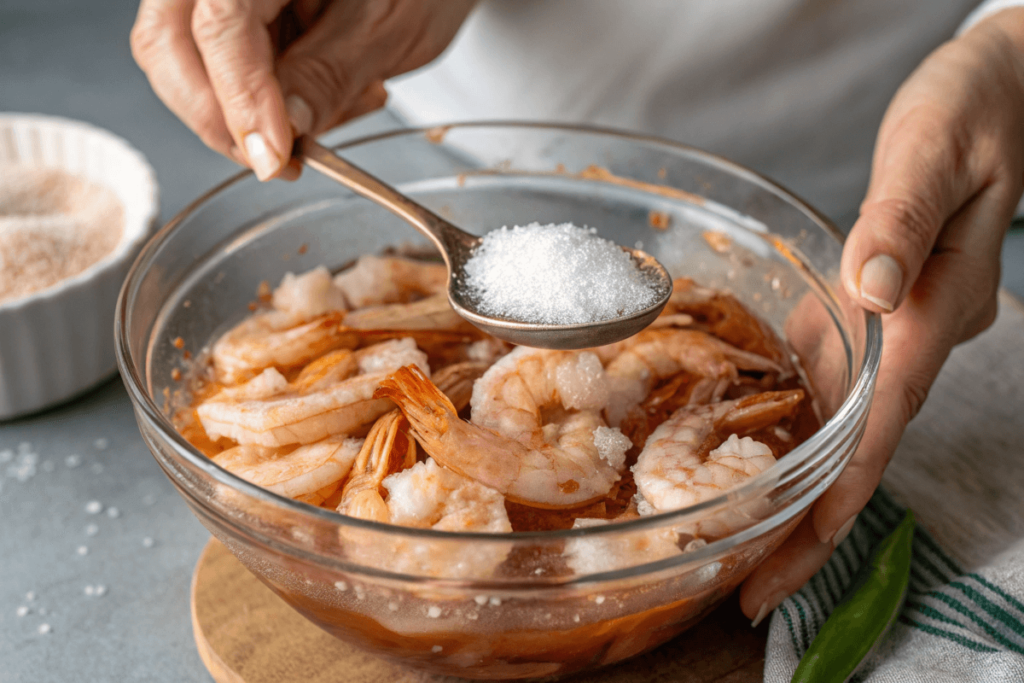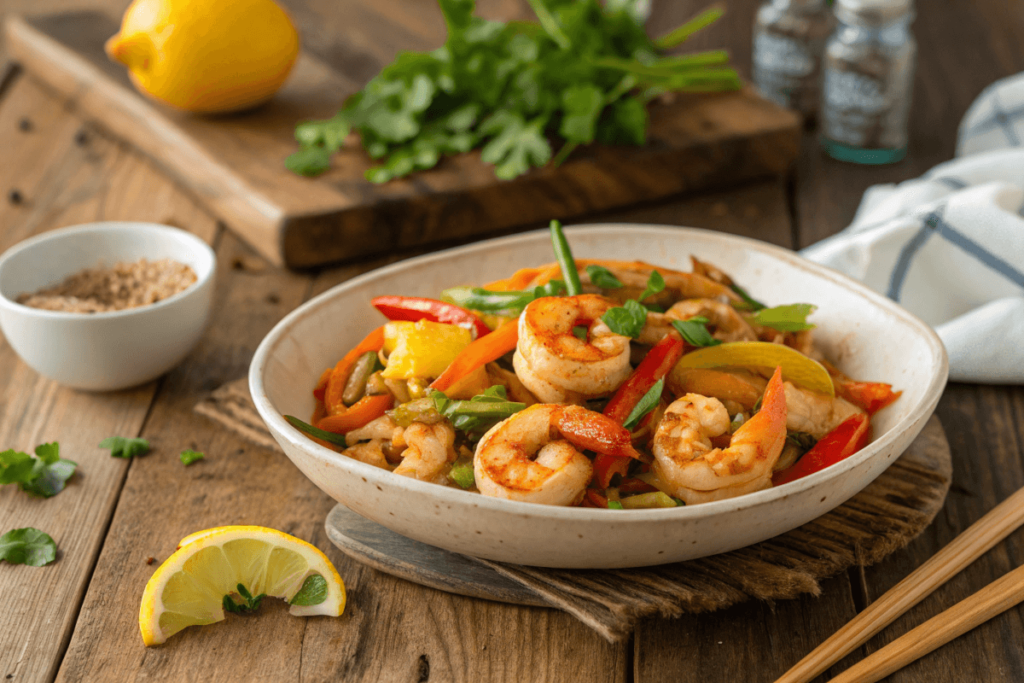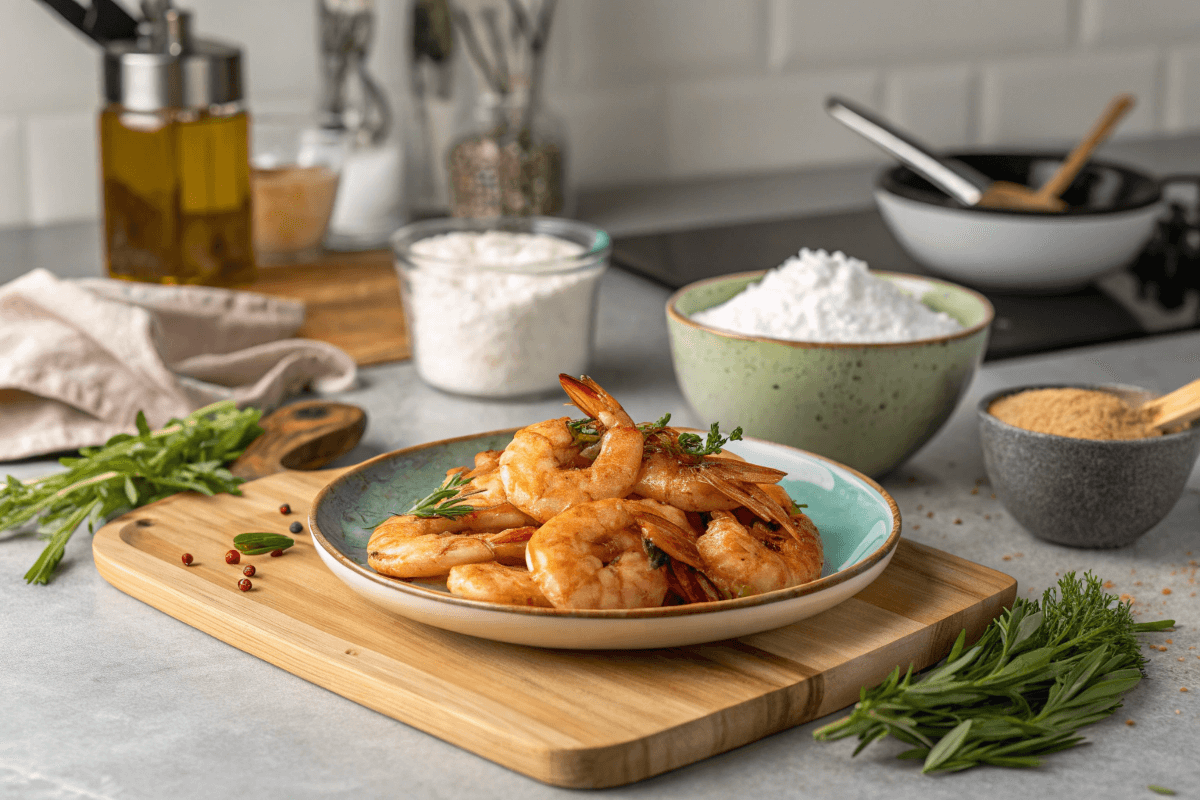Shrimp are a beloved seafood delicacy, but achieving the perfect texture and flavor can be a bit tricky. Whether you’re a seasoned chef or an amateur cook, you might’ve heard of a surprising kitchen hack: using shrimp baking technique. Why do people do this? What makes this simple pantry ingredient a game-changer in shrimp preparation? In this article, we’ll explore the science, techniques, and benefits behind this culinary trick. From tenderizing the meat to enhancing flavor, we’ll cover everything you need to know to cook shrimp like a pro.
Let’s dive right in and uncover the magic of baking soda!
The Role of Baking Soda in Cooking Shrimp
What Is Baking Soda and How It Works in Cooking?
Baking soda, scientifically known as sodium bicarbonate, is a versatile alkaline compound that’s a staple in many kitchens. But beyond its use in baking and cleaning, baking soda works wonders in cooking. Its alkaline nature raises the pH level of food, which can significantly alter texture and flavor.
When applied to shrimp, baking soda works as a tenderizer by loosening the proteins in the shrimp’s flesh. This process results in a firmer yet juicier texture, making your shrimp plump and succulent after cooking. Who knew such a simple ingredient could work culinary wonders?
How Baking Soda Affects the Texture of Shrimp
Shrimp naturally have a slightly firm and chewy texture, but this can sometimes veer into rubbery territory if overcooked. Here’s where baking soda steps in like a hero. By raising the pH, baking soda reduces the shrimp’s tendency to contract during cooking, helping them retain moisture and stay juicy.
This effect is particularly noticeable in stir-fried or grilled shrimp, where high heat often causes protein tightening. With baking soda, your shrimp stay perfectly tender no matter how you cook them.
Chemical Reactions Between Baking Soda and Shrimp Proteins
At a molecular level, baking technique works by breaking down certain proteins in the shrimp, specifically the myosin and actin fibers that are responsible for its rigidity. When these proteins are loosened, the shrimp becomes more tender and less prone to drying out.
Interestingly, the alkaline properties of baking soda also promote mild browning during cooking, enhancing the visual appeal of your dish. A light golden crust forms on shrimp when sautéed, giving it that irresistible crispy-yet-tender balance.
Benefits of Adding Baking Soda to Shrimp
Enhancing Shrimp’s Tenderness and Juiciness
One of the standout advantages of using shrimp baking technique is its ability to make them incredibly tender and juicy. The alkaline nature of baking soda interacts with the shrimp’s natural proteins, reducing their tendency to tighten when exposed to heat. This gentle tenderization process helps the shrimp retain their moisture, resulting in a plump and succulent texture that’s hard to achieve with other methods.
In high-heat cooking, such as grilling or stir-frying, shrimp often lose their natural juices, turning rubbery. Adding a small amount of baking soda to your marinade acts as a safeguard, ensuring every bite is as juicy as possible. This is why seasoned chefs recommend this technique for achieving restaurant-quality shrimp.
Improving Flavor Through pH Balancing
Baking soda doesn’t just improve texture; it also enhances flavor. By altering the shrimp’s pH level, baking soda can help neutralize any lingering brininess, bringing out the shrimp’s naturally sweet and savory flavors. This subtle shift in pH creates a clean, balanced taste profile, allowing your shrimp to shine in any dish, whether it’s a simple stir-fry or an elegant shrimp salad.
Additionally, shrimp baking technique develop a mild crust when cooked, giving them a delightful balance of softness and crunch. This texture contrast makes your shrimp dishes even more enjoyable.
Ensuring Consistent Cooking Results with Baking Soda
Ever struggled with shrimp that cooked unevenly? Baking soda helps resolve this issue. Its ability to slightly break down the surface proteins ensures even heat distribution during cooking. As a result, each piece cooks consistently, making it easier to achieve a uniform look and texture, whether you’re sautéing, grilling, or broiling.
Techniques for Using Baking Soda on Shrimp

How to Marinate Shrimp with Baking Soda
shrimp baking technique is incredibly simple, but it requires the right technique. Start by preparing your shrimp—whether peeled, deveined, or left in their shells. For every pound of shrimp, mix 1 teaspoon of baking soda with 2-3 tablespoons of water. Toss the shrimp in this mixture, ensuring they’re evenly coated. Let the shrimp marinate in the refrigerator for 15-30 minutes.
This short marination time is all you need to unlock the tenderizing magic of baking soda. Afterward, rinse the shrimp thoroughly to remove any excess baking soda, pat them dry, and cook as desired.
Duration and Proportions for Effective Results
The key to perfect shrimp lies in moderation. Overusing baking soda can lead to a mushy texture and an unpleasant alkaline aftertaste. Stick to the recommended proportions, and avoid marinating for longer than 30 minutes. If you’re working with smaller shrimp, a shorter marination time, around 10-15 minutes, is ideal.
Common Mistakes to Avoid When Using Baking Soda
While baking soda is a powerful tool, improper use can backfire. One common mistake is skipping the rinsing step. If the baking soda isn’t thoroughly washed off, it can leave a soapy taste. Another error is using too much baking soda, which can overly break down the proteins and ruin the texture.
For a detailed guide on how to handle shrimp for various dishes, check out this shrimp salad recipe, where shrimp baking technique plays a key role in perfecting texture and flavor.
Next, we’ll dive deeper into alternative shrimp tenderizing techniques and compare them with baking soda. Stay tuned!
Comparisons with Other Shrimp Tenderizing Methods
Baking Soda vs. Salt: Which Is Better?
When it comes to tenderizing shrimp, baking soda and salt are two popular contenders. But how do they stack up against each other? Baking soda is an alkaline substance that works by raising the shrimp’s pH, loosening proteins, and locking in moisture. Salt, on the other hand, primarily works through osmosis, drawing out water to firm up the shrimp’s flesh.
For those seeking tender, juicy shrimp, baking soda marinade is often the better choice. Its ability to maintain moisture while preventing over-shrinking during cooking makes it ideal for stir-fries or grilled shrimp. Salt, while effective, can sometimes lead to slightly tougher results if overused. Still, it’s a great alternative for a quick brine or when baking soda isn’t on hand.
Comparing Acidic Marinades to Baking Soda
Acidic marinades like lemon juice or vinegar have long been used to tenderize seafood, but they work very differently from baking soda. Acids break down proteins by lowering the pH, which can tenderize shrimp but may also cause them to become mushy if left too long.
In contrast, baking soda gently loosens proteins without compromising the shrimp’s structure. Additionally, acidic marinades often add distinct flavors, which may or may not complement your dish. Baking soda’s neutral impact on flavor gives you more control over your recipe.
Traditional Chinese Velveting Technique vs. Baking Soda Method
The velveting technique, widely used in Chinese cuisine, involves marinating shrimp in a mixture of cornstarch, egg whites, and sometimes baking soda. This method creates a silky, smooth texture perfect for stir-fries. While velveting is great for certain dishes, baking soda alone offers a simpler, faster alternative with equally impressive tenderizing results.
For more seafood preparation tips, check out our comprehensive shrimp salad recipe.
Scientific Studies and Culinary Expertise on Baking Soda and Shrimp
Research on Tenderizing Effects of Baking Soda
Scientific studies back the claim that hrimp baking technique is highly effective in tenderizing shrimp. Research shows that its alkaline properties reduce protein contraction, which helps retain moisture and improve texture. This process is particularly beneficial for high-heat cooking methods, where shrimp are prone to drying out.
Moreover, baking soda’s ability to enhance surface browning makes it a favorite among chefs seeking that perfect crispy-yet-tender bite. The science behind baking soda’s effectiveness is so compelling that many culinary schools now include it in their teaching of seafood preparation.
Insights from Professional Chefs
Professional chefs swear by baking soda as a game-changing ingredient in shrimp preparation. According to culinary experts, baking soda is particularly useful when cooking shrimp for dishes like shrimp tacos, stir-fries, or even creamy pasta. It ensures that the shrimp stay plump and tender, even when exposed to intense heat.
Chefs also appreciate baking soda’s versatility. It’s an easy-to-use ingredient that pairs well with other marinades, allowing cooks to explore endless flavor combinations. Whether you’re a home cook or a seasoned pro, understanding why you put baking soda in shrimp can elevate your seafood dishes to a whole new level.
For more delicious recipes and cooking tips, don’t miss our guide to making shrimp tacos with fresh ingredients.
Next, we’ll address some of the most frequently asked questions about using baking soda on shrimp. Stay tuned!
Frequently Asked Questions (FAQs)
How Long Should I Leave Shrimp in Baking Soda?
The marination time is crucial when using baking soda on shrimp. Typically, 15-30 minutes is all you need to achieve tender, juicy results. Leaving the shrimp in baking soda for too long may lead to an overly soft texture. If you’re using smaller shrimp, marinate them for 10-15 minutes for optimal results.
Does Baking Soda Affect Shrimp’s Taste?
Not at all—when used correctly. Baking soda subtly enhances the shrimp’s natural sweetness without leaving an alkaline or soapy aftertaste. Just be sure to rinse the shrimp thoroughly after marinating to avoid any residue.
Can I Use Baking Powder Instead of Baking Soda?
While baking powder shares some properties with baking soda, it’s less effective for tenderizing shrimp due to its added ingredients like cream of tartar. Stick to baking soda for the best results.
Is Baking Soda Safe for All Types of Shrimp?
Yes, baking soda works well on all shrimp varieties, from tiger shrimp to small pink shrimp. It’s a versatile tenderizer that complements different cooking styles.
Cooking Recipes Using Baking Soda and Shrimp
Stir-Fried Shrimp with Vegetables
This quick and easy stir-fry is perfect for showcasing the benefits of baking soda. After marinating the shrimp with baking soda, rinse, dry, and toss them in a hot wok with your favorite vegetables—such as bell peppers, snap peas, and carrots. The shrimp will stay tender and juicy, creating a delightful contrast with the crisp veggies. Serve with steamed rice or noodles for a complete meal.

Crispy Fried Shrimp Recipe
For an irresistible crunch, baking soda works wonders in fried shrimp recipes. Coat the marinated shrimp in a light batter made from cornstarch and flour. Fry them until golden brown, and pair with a tangy dipping sauce for a crowd-pleasing appetizer. shrimp baking technique ensures the shrimp remain juicy inside, even after deep-frying.
Shrimp in Creamy Garlic Sauce
If you’re craving something indulgent, try this creamy garlic shrimp recipe. After using baking soda to tenderize the shrimp, sauté them in butter and garlic, then simmer in a rich cream sauce with a hint of Parmesan. Toss with pasta or serve over rice for a comforting dish that highlights the shrimp’s plump texture.
For more cooking inspiration, explore other delicious recipes on our site. Why do you put baking soda in shrimp? Try these recipes to see for yourself!
Next, we’ll conclude with final thoughts on this cooking technique and why it’s worth a try. Stay tuned!
Conclusion and Final Thoughts
Summarizing the Benefits of Baking Soda for Shrimp
By now, it’s clear why baking soda is a must-have for cooking shrimp. From tenderizing the meat to enhancing its natural flavors, baking soda transforms ordinary shrimp into a culinary delight. Whether you’re making a quick stir-fry or a crispy fried appetizer, this simple trick guarantees juicy, perfectly cooked shrimp every time.
Encouraging Experimentation in the Kitchen
So, why do you put baking soda in shrimp? The answer lies in its ability to elevate your dishes with minimal effort. Don’t be afraid to experiment—try this technique in your favorite shrimp recipes and taste the difference for yourself. With a little practice, you’ll have your family and friends asking for your secret to delicious shrimp every time!
FAQs: Exploring Reader Curiosities
Can You Combine Baking Soda with Other Marinades?
Yes, baking soda works well with other marinades, such as garlic and herb mixtures. Just be cautious with acidic ingredients, as they can counteract baking soda’s tenderizing effects.
Should You Rinse Shrimp After Using Baking Soda?
Absolutely. Rinsing removes any excess baking soda, preventing any residual taste. A quick rinse under cold water ensures your shrimp are ready for cooking.
Thank you for reading! For more tips and tricks, explore our recipe section and experiment confidently in your kitchen!

